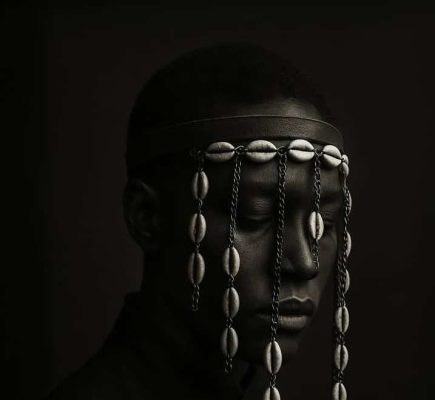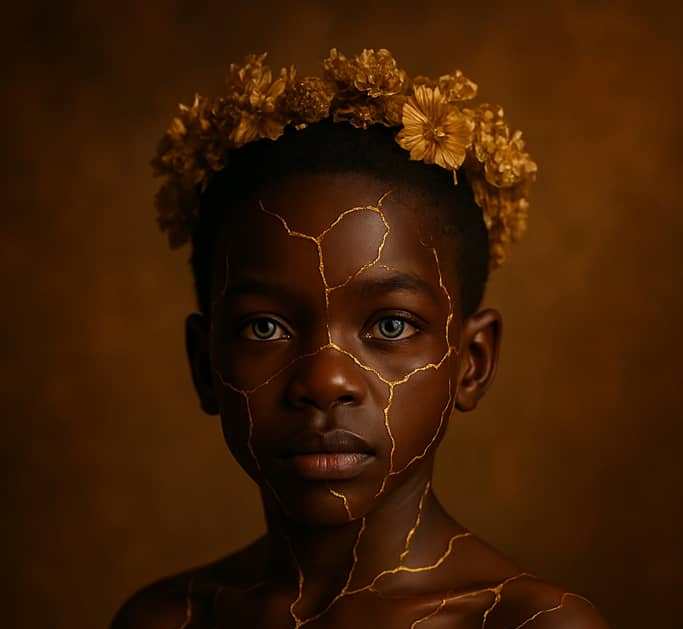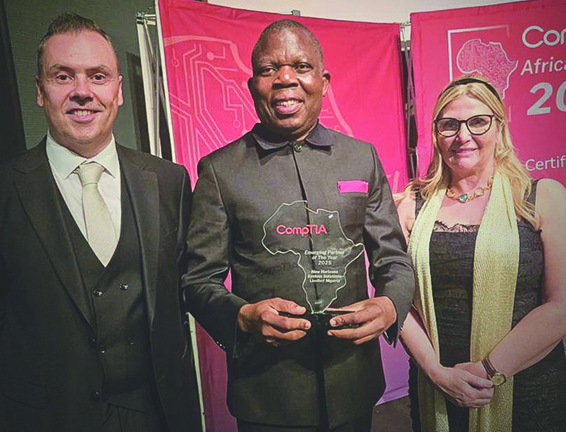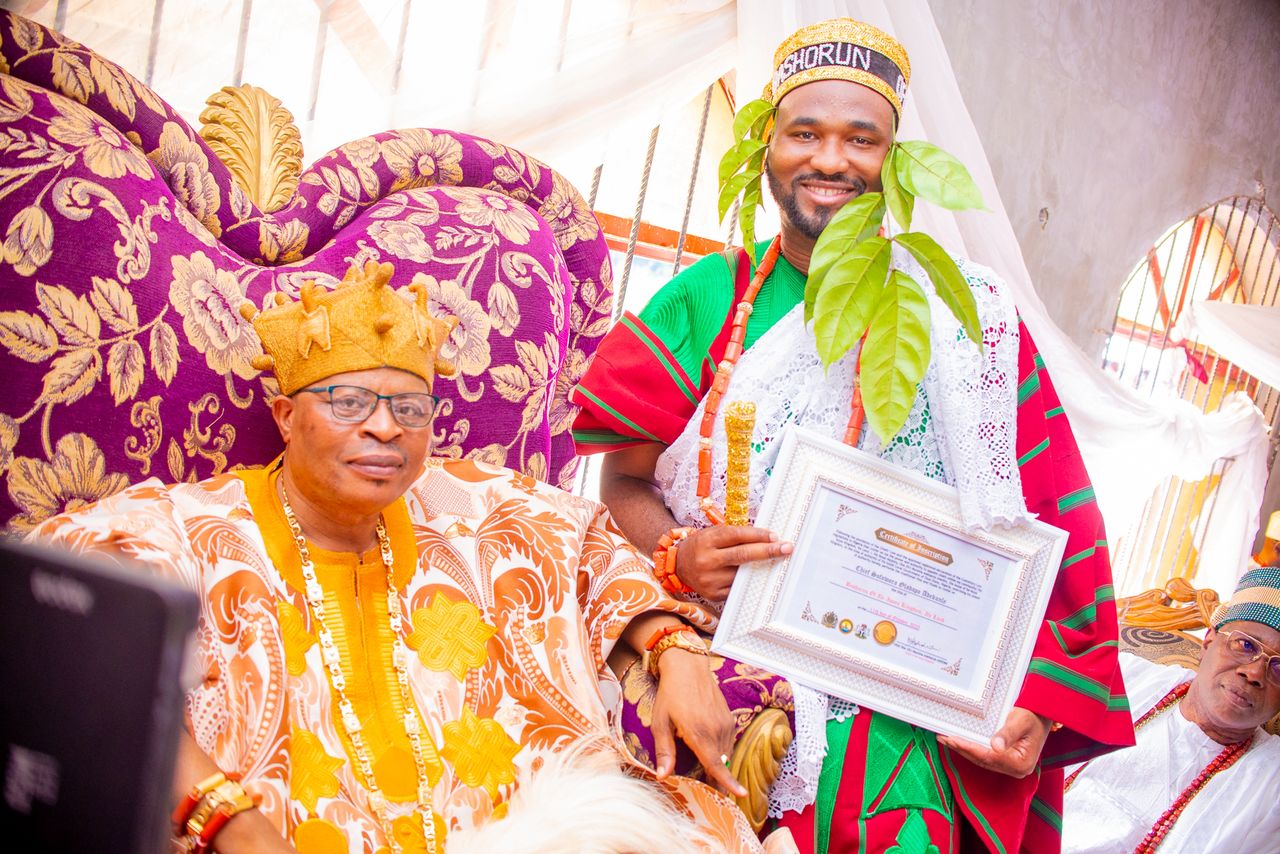Despite initial aspirations of becoming a legal or medical practitioner, Awoyomi’s heart has always been drawn into the art of capturing images with lens. His work has gone to help the viewer have a deeper conversation with reality. His artworks do not politely request the viewer’s attention; they command it.
At the centre of his practice is a deliberate reconfiguration of the gaze. Steeped in Afrocentric symbolism yet executed with a precision and restraint reminiscent of classical portraiture, his works operate in the charged space between memory and reinvention.
In an era where the ‘representation’ of Black bodies has turned to visual cliché, Awoyomi insists on complexity, dignity and spiritual depth. His audiences are left immersed in the intricate layers of identity, memory and culture narratives. He allows his lens to be both the voice and eyes voices for what he wants to say and do.
The artist’s emphasis on the eyes in his portraits is a particularly powerful choice, as the eyes are often seen as windows to the soul, capable of conveying a multitude of emotions and stories.
His moment in creative photography came when he was adjudged the best in the student category of the highly competitive British Institute of Professional Photography’s International Photographer of the Year Award.
From the Veil of Origin, a series that explores intersection of ancestral memory, spiritual regality and Afrocentric symbolism, he invites viewers into a quiet, contemplative space where the body becomes canvas, and adornment becomes language: a celebration of heritage, an assertion of beauty, and a gesture toward the divine.
Captured in Dakar, figures emerge from darkness wearing ceremonial veils of cowrie shells and metallic chains. These adornments are not props; they are cultural signifiers, ritual objects, and armour.
The compositions draw the viewer into a game of revelation and concealment: the singular exposed eye, sometimes unyielding, sometimes, meditative, functions as a locus of human gaze. For Awoyomi, the eyes do not merely look back, they reclaim space.
 The dynamics of these pictorial compositions are filled with actions and non-static gestures, signalling a newness of creative consciousness. Each portrait is a meditation on identity, resilience and wealth. The cowrie veil, symmetrically arranged, functions as a shield, a ritual and ornamentation.
The dynamics of these pictorial compositions are filled with actions and non-static gestures, signalling a newness of creative consciousness. Each portrait is a meditation on identity, resilience and wealth. The cowrie veil, symmetrically arranged, functions as a shield, a ritual and ornamentation.
Taking its roots from the seamless local stories, dialogues and other range of compositional phrasings, he explores the depth and complexity of delicate intersection between aesthetics and visualisation, Awoyomi shows how the lens becomes a tool not just to document, but to provoke, question, and inspire.
His technical control is equally deliberate. Minimalist, moody backdrops strip away distractions, while shadows and soft directional light carve the sitter’s features with almost sculptural precision. The interplay recalls the chiaroscuro of 17th-century European masters, yet here it serves a wholly different purpose: not to glorify colonial visions of the exotic, but to elevate Black presence as sovereign and self-authored.
Shadows and soft directional light sculpt the subject’s features like stone, echoing the sacred stillness of statues yet alive with breath and intention. The work is not just a pictorial composition, but an ode to the divine. It is a testament to the changing times, as what once held immense significance as symbols of wealth, ancestry, fertility, and healing, is now an object of decoration.
The singular exposed eye sometimes intense, sometimes, at peace pierces through the obscurity to reclaim gaze and presence. In one image, an ancient oil lamp lights the subject from the side, casting golden warmth on dark skin and invoking themes of inner illumination and spiritual continuity.
In Edikwansa: Faces of the Forefathers, the artist presents a series of portraits that operate as both an act of remembrance and a bold reclamation of visual sovereignty. Against an austere black backdrop, each composition stages a theatre of ancestral presences: five or four figures, draped in densely patterned cloth, wearing masks that oscillate between the sculptural and the human. These masks, with their polished surfaces, geometric scarifications, and horned or crested crowns, are not merely adornments; they are vessels, carriers of memory and repositories of an unbroken cultural lineage.
The series immediately resists the ethnographic gaze. Rather than exorcising the mask as an object, the work situates it within a living, breathing body, dignified and unyielding.
The artist’s lens treats these faces not as relics, but as interlocutors, figures that look back at the viewer with equal, if not greater, intensity. In this reversal, the photographic act becomes a negotiation of power: who is seeing, and who is being seen?
The choice of textile is far from incidental. Each cloth is a palimpsest of symbols, colours, and encoded histories, its folds echoing the undulating timelines of migration, ritual, and resistance.
The interplay between the matte, earth-toned masks and the luminous, patterned fabrics set up a visual rhythm a call-and-response between surface and depth, tradition and reinvention.
There is an almost liturgical stillness in the staging, yet beneath it lies silent interrogation of form. By rendering these figures with monumental presence, the artist collapses the temporal gap between forebears and descendants. The masks, traditionally markers of ceremony or spiritual mediation, here act as bridges between continents and generations a visual pronouncement that the past is not past.
If there is a risk in the work, it lies in its perfection. The symmetry of composition, the hyper-controlled lighting, and the polished finish flirt with an aestheticisation that could, in lesser hands, slide into fashion editorial territory. But here, the formal precision serves the conceptual rigour: the immaculate surfaces are a deliberate counterpoint to colonial misrepresentations of African art as “primitive” or “rough-hewn.” This is heritage reframed as regal, sovereign, and unapologetically contemporary.
Ultimately, Edikwansa is an act of visual sovereignty. It asks the viewer to reckon with the fact that these faces these presences are not lost in the archive, but alive, unyielding, and looking back at us with the gaze of those who have always been here.
In Heirloom of Light, Awoyomi explores the childhood. Each frame is sculpted with cinematic lighting and softness evoking not just an image, but a feeling. The golden dried floral crowns and delicate jewelry trace a lineage of beauty, ritual, and nobility often unseen in traditional Western narratives of Black childhood. Here, innocence is power.
The child’s gaze, steady and knowing, commands space with a quiet authority that transcends age.
This piece centres on a dark-skinned child, looking confident and optimistic of what the future holds despite the vicissitude of life. He uses the golden marks on the face, particularly forehead, cheek and neck as focal points of attractions. Yet, these elements form part of the child’s rich heritage.
Heirloom of Light symbolises the celebration of a valuable inheritance of her people, who continued to resist the influence of foreign cultures. The image of the young girl also embodies all the rich trappings of her cultural heritage. Awoyomi’s handling of the colour scheme, particularly the congruous nature of black and gold as background, further reinforces the depth of the photograph and its appeal.
Through a fusion of high-resolution photographic technique, emotional depth, and symbolic detail, Awoyomi invites viewers to confront and reconsider the aesthetics of royalty, spirituality, and legacy.
While in Golden Fractures, he explores the quiet resilience of childhood and the sublime beauty that emerges through healing. This portrait draws inspiration from the Japanese philosophy of Kintsugi.
The central figure a dark-skinned male child with luminous blue eyes stands adorned with delicate gold leaf cracks across his face and body. These golden lines do not hide imperfections; they illuminate them. He wears a crown of dried golden flowers and a flowing, muted gown, set against a warm, softly lit backdrop that glows with a sense of spiritual intimacy.
Through cinematic lighting, shallow depth of field, and careful texture layering, he invites the viewer to witness fragility transformed into sacred ornament. The eyes sometimes full of light, other times, ghostly pale offer a haunting gaze into innocence shaped by unseen trials.
His recurring theme of Black heritage and identity, childhood, vulnerability, and renewal resonate. However, he blends this traditional portraiture with symbolic abstraction, standing as a tribute to the quiet power in being both broken and whole.
Awoyomi’s contribution to contemporary art lies not merely in his technical mastery, but in his refusal to let the Black body be framed solely through external definitions. His work participates in the same global conversation as Zanele Muholi’s photographic activism and Kehinde Wiley’s regal subversions of European portraiture, yet it carries a distinct voice rooted in West African heritage, sharpened by diasporic experience, and unafraid of abstraction.
In viewing his oeuvre, one is reminded that portraiture, at its most potent, is not about likeness alone. It is about power who holds it, who defines it, and how it is visually negotiated. Awoyomi’s photographs are not only images; they are interventions.






